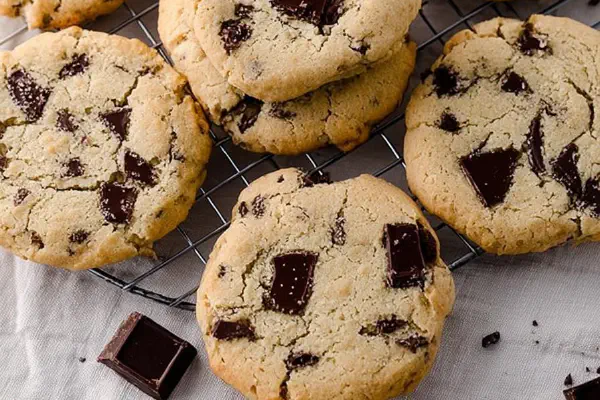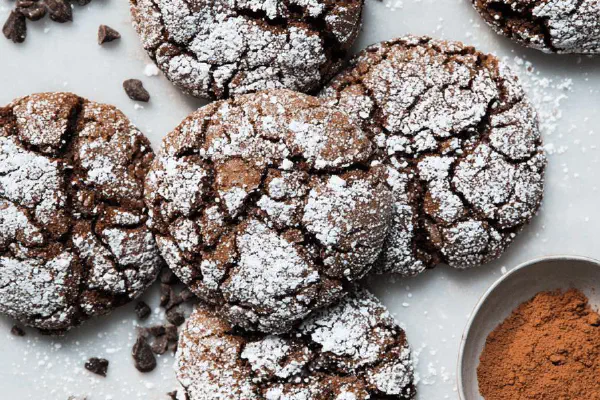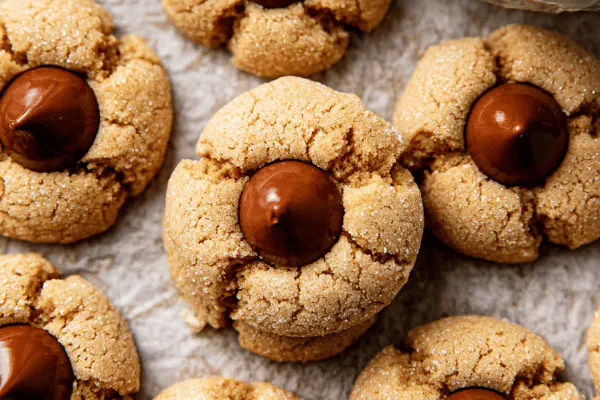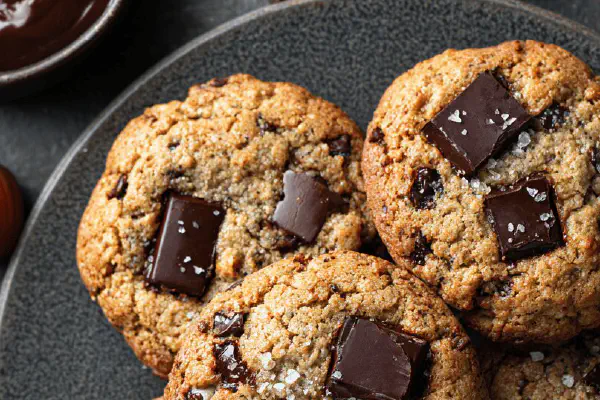Featured Recipe
Cocoa Coconut Cookies
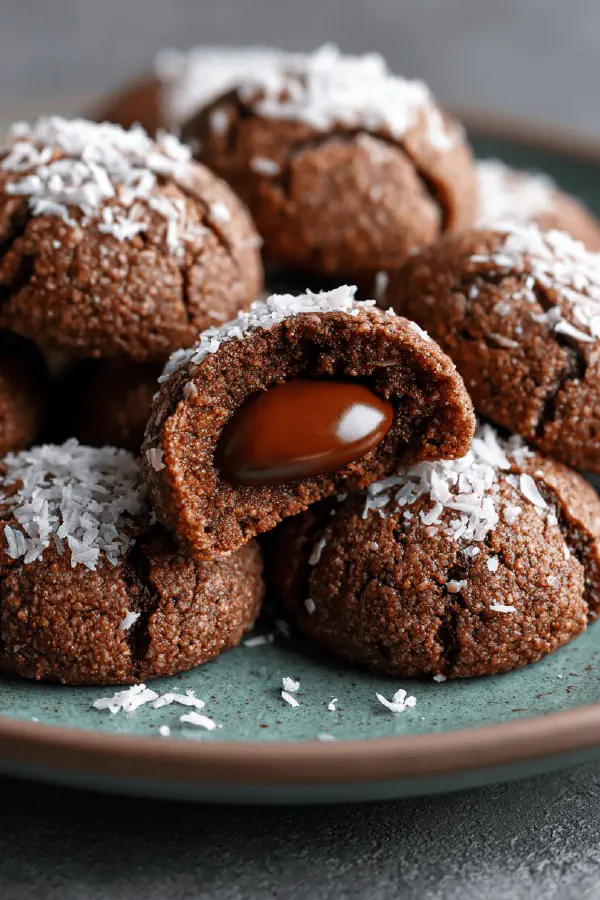
By Kate
"
Dairy-free, nut-free chocolate cookies with a chewy coconut exterior and a milk chocolate center. Uses cassava flour and maple syrup to adjust texture and sweetness. Coconut oil adds richness and moisture. The chocolate filling is enhanced with a pinch of cinnamon, bringing warmth to the flavor. Baking guided by visual cues like golden edges and toasted coconut. Hands-on shaping ensures consistent size. Recipes adjusted for timing and ingredients for texture balance. Store airtight at room temp up to a week.
"
Prep:
35 min
Cook:
15 min
Total:
50 min
Serves:
2 dozen
dessert
cookies
gluten-free
dairy-free
chocolate
Introduction
Start with simple pantry staples. Cassava flour swaps wheat; lends slight chew, more rustic mouthfeel. Cocoa powder adjusted—adds noticeable chocolate sharpness without dominating. Arrowroot powder replaces cornstarch; gives subtle crispness instead of gumminess. Coconut oil used refined for neutral fat, not overpowering coconut flavor. Powdered erythritol lowers sugar load, but pure sugar will work where here it’s called out. Cinnamon sprinkled into coconut doubles as warming nut-free spice, subtle but cutting sugar edge. Expect chewy cookies dotted with slightly toasted coconut crunch. Holds shape well but softens slightly with time. Chocolate filling fills the thumbprint pocket, melts slowly at room temp. Patience key. Baking times vary by oven, watch for golden tints in topping to signal done. It’s about eyes and touch, not timer alone. Cool fully before chocolate or meltdown follows. These are sturdy enough to pack or gift but delicate enough to savor.
Ingredients
Cookies
- 105 g (3/4 cup) cassava flour
- 32 g (1/4 cup + 1 tbsp) unsweetened cocoa powder
- 30 ml (2 tbsp) arrowroot powder
- 1 ml (1/4 tsp) fine sea salt
- 125 ml (1/2 cup) refined coconut oil
- 85 g (1/2 cup) powdered erythritol or superfine sugar
- 1 large egg
- 1 egg white
- 60 g (1/2 cup) sweetened shredded coconut
- 85 g (3 oz) chopped milk chocolate
- 5 ml (1 tsp) coconut oil
- 1/4 tsp ground cinnamon
Topping and Filling
About the ingredients
Cassava flour works well here—it hydrates differently; no gluten means handle dough gently, avoid overmixing. Arrowroot powder gives lighter structure than cornstarch. You can swap with tapioca starch if needed but expect slightly softer cookie. Refined coconut oil here avoids strong coconut scent, but virgin can be used for bolder aroma; watch for flavor shift. Powdered erythritol helps maintain tender crumb and smooth surface; granulated sugar or powdered sugar can substitute but alter texture slightly. Sweetened shredded coconut packs moisture; unsweetened versions work but may dry cookies without slight sugar addition elsewhere. Egg binds the mixture but avoid overbeating—keeps dough from toughening. Chocolate chose milk for creaminess but dark chocolate can be swapped if preferred—just note bitterness shift. Cinnamon in topping is a twist but optional—adds nice depth missing otherwise.
Method
Cookies
- Whisk cassava flour, cocoa powder, arrowroot powder, salt in a bowl until thoroughly combined. Important. Sift if clumpy. Avoid lumps; they ruin texture.
- In another bowl, beat coconut oil with erythritol until pale and creamy—takes about 3 minutes at medium speed. Scrape sides. Add egg, mix until fully incorporated but don’t overbeat—just blend. Fold in dry mix gently with wooden spoon or spatula. Do not overmix; gluten formation unnecessary here, handle lightly.
- Preheat oven to 175 C (350 F). Middle rack. Line baking sheet with silicone mat or parchment paper. No sticking, easy lift.
- Beat egg white lightly in small bowl. Separate bowl for coconut with cinnamon mixed in well. Toss together until cinnamon evenly spread. Adds subtle warmth, don’t skip.
- Scoop dough using 15 ml measuring spoon (or ice cream scoop) into rough balls. Roll in hands gently until smooth, about 4 cm diameter. Roll balls first in egg white, let excess drip.
- Then roll in cinnamon coconut mix, press to coat well. Use tips of fingers or back of spoon to press center gently to create a small indentation. Avoid cracks but press firmly. Creates pocket for chocolate. If cracks form, pinch dough edges carefully back together.
- Place cookies 5 cm apart on tray. Don’t crowd—cookies spread and brown at edges—air circulation key.
- Bake 13-17 minutes. Watch coconut color—light golden with toasted aroma means done. Edges firm but centers still slightly soft beneath toasted coconut. Underbaking = crumble, overbaking = dry. Trust eyes and nose.
- Remove from oven. Cool whole tray on wire rack at least 1 hour. Let cookies firm before filling. Hot cookies cause melted mess.
- Melt chopped chocolate with coconut oil in microwave-safe bowl; 20 seconds bursts, stir each time. Warm but not hot. Stir until smooth glossy. Cinnamon in topping avoids need to spice here.
- Spoon chocolate into each cookie’s center cavity generously. Do not overfill or it spills.
- Let rest at room temp until chocolate sets, about 1.5 to 2.5 hours depending on humidity. Avoid fridge; condensation dulls surface and softens coconut topping.
- Store cooled cookies in airtight container at room temp. If you notice softening, replace coconut topping by lightly toasting fresh shredded coconut and sprinkling over hardened chocolate centers.
- Dry dough? Cassava flour absorbs differently than wheat; add small splash water or extra fat if crumbly.
- Cookies flatten? Chill dough 10 minutes before shaping.
- Chocolate filling not setting? Cool longer or reduce coconut oil by 1 tsp; excessive oil keeps filling soft.
- Coconut turns greasy? Use unsweetened shredded coconut for less oil release.
- No erythritol? Regular or powdered sugar fine; expect slightly different sweetness and texture.
Topping and Shaping
Filling
Troubleshooting
Technique Tips
Use light yet thorough mixing to keep tender texture; overbeating egg with sugars can cause spread. Incorporate dry ingredients just till combined. Shape dough balls uniformly for even baking; size affects bake time. Rolling in egg white then coconut ensures crunchy shell that sticks persistently through baking, no slipping. Creating indentation with fingertip is classic technique to hold filling; don’t skip or over-press and risk cracking. Watch coconut edges for golden hints, rely on aroma to avoid burnt notes. Cool completely before filling—hot cookie plus melted chocolate equals messy flooding. Melt chocolate carefully in short bursts, stir to prevent grainy finish. Adding coconut oil thins chocolate for easy filling but too much keeps it soft, balance crucial. Let set at room temp—fridge ruins coconut texture and dulls chocolate shine. Storage in airtight container at room temp is best; refrigeration makes coconut topping weep and chocolate bloom. Small adjustments in flour or fat change dough behavior; chill dough if it’s too sticky. Overall, patience and sensory attention win here.
Chef's Notes
- 💡 Cassava flour absorbs differently. Adjust fat for sticky dough. A splash of water helps too. Don’t overwork the dough, avoid gluten formation.
- 💡 Watch the coconut when baking—golden edges mean cookies are close. Aroma triggers readiness. Pull out before edges burn, centers should be soft.
- 💡 Rolling the dough in egg white, coconut creates crust. This crunchy shell sticks well while baking; ensures cookies don’t lose topping.
- 💡 Creating a thumbprint in the center helps hold chocolate. Press gently; avoid cracking. Indentation is key for that melted filling.
- 💡 Set at room temperature to harden chocolate filling. Don’t rush to chill in fridge. Humidity plays a role in how quickly it sets.
Kitchen Wisdom
What if the dough is too dry?
Add a little water or oil. Dough varies with flour hydration. Be cautious, too much alters texture.
Cookies are too flat?
Chill dough for 10 minutes. Spread often occurs with warm dough. Rolling helps maintain shape during baking.
How to store these cookies?
Use an airtight container at room temp. If coconut softens, refresh coating with toasted coconut.
Chocolate filling not setting right?
Reduce coconut oil slightly. Too much oil keeps filling soft—balance is crucial for a good texture.
